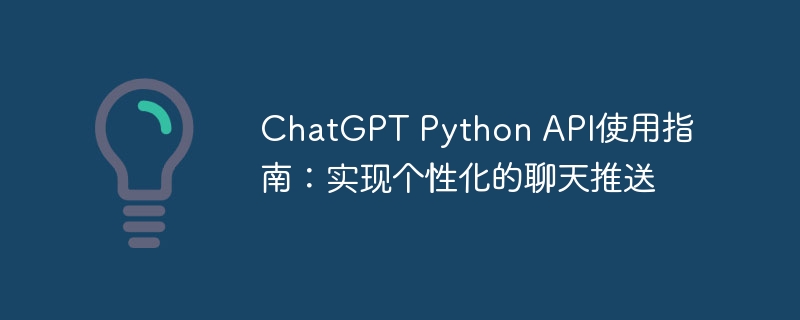

ChatGPT Python API Usage Guide: Implementing Personalized Chat Push
Introduction:
In today’s Internet era, people have an increasing demand for personalized services high. ChatGPT is a natural language processing model based on the clipboard model, which is very suitable for implementing a personalized chat push system. This article will describe how to use ChatGPT's Python API to achieve this goal, and provide specific code examples.
1. Preparation:
Install the ChatGPT library: First, you need to install the ChatGPT library. You can install it by running the following command using the pip tool:
pip install openai
2. Using ChatGPT Python API:
Using ChatGPT’s Python API, we can get ChatGPT’s reply by sending a list containing user input and system prompts. The following is a code example that uses the ChatGPT Python API to implement personalized chat push:
import openai
def get_chat_response(user_input, system_prompt, api_key):
openai.api_key = api_key
chat_log = system_prompt + user_input
response = openai.Completion.create(
engine="davinci-codex",
prompt=chat_log,
temperature=0.7,
max_tokens=150,
top_p=1.0,
frequency_penalty=0.0,
presence_penalty=0.0
)
chat_reply = response.choices[0].text.strip().split('
')[0]
return chat_reply
# 示例系统提示和用户输入
system_prompt = "系统:今天你想聊点什么呢?"
user_input = "用户:我想了解最近的天气情况。"
# 调用ChatGPT API获取回复
api_key = "YOUR_API_KEY"
response = get_chat_response(user_input, system_prompt, api_key)
# 输出聊天回复
print(f"ChatGPT回复:{response}")In the above code example, we first define a function named get_chat_response, which will User input and system prompts are taken as parameters and ChatGPT's response is returned. Then, we set up the system prompt and user input, and call the get_chat_response function to get the reply. Finally, we output ChatGPT's reply to the console.
Please note that when using the ChatGPT Python API, we need to pass in parameters such as temperature (temperature), maximum number of tokens (max_tokens), etc. to control the generation behavior of the ChatGPT model. It can be adjusted according to actual needs.
3. Conclusion:
This article introduces how to use ChatGPT’s Python API to implement personalized chat push. By following the code examples provided in this article, you can easily build your own ChatGPT application and customize it to your personal needs. I wish you success in implementing your own chat push system!
(Note: This article only provides code examples and does not cover all details and exception handling. In actual applications, please further improve and debug according to your needs.)
The above is the detailed content of ChatGPT Python API usage guide: implementing personalized chat push. For more information, please follow other related articles on the PHP Chinese website!




